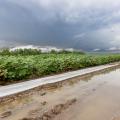Potassium
Potassium is essential in the growth and development of the cotton plant. Potassium is essential for many of the enzyme systems in the plant, plays a role in reducing the incidence and severity of the wilt disease, increases water efficiency, affects the speed of almost all plant biological systems, and affects fiber properties such as micronair, length, and strength. Uptake of potassium increases during early boll set with some 70 percent of total uptake occurring after first bloom.
Potassium deficiency symptoms appear as a yellowish-white mottling to a light-yellowish-green color with yellow spots appearing between the veins. The centers of these spots die, and numerous brown specks occur at leaf tips, around margins, and between veins. The tips and margins break down first and curl downward. As symptoms progress, the whole leaf becomes reddish brown, dries, and becomes scorched and blackened in appearance. Premature dropping of leaves is also characteristic and may affect boll development resulting in bolls not maturing or only partially opening and containing poor quality fiber.
The most common source of potassium is muriate of potash (0-0-60). Other sources include potassium sulfate and potassium nitrate.
Follow soil test recommendations where yield potential is less than two bales per acre. If a field has a realistic yield goal of two bales or more, increase the potash rates by 50 percent over the recommendation given on a soil test report from the MCES Soil Testing Laboratory. In some areas of the Delta bordering the brown loam hills, there seems to be some soils that historically test low in potassium, regardless of the use rates. Fields on these soils generally tend to have wilt problems or problems with premature cutout and premature leaf drop. Research is being conducted on these soils to determine the possible cause of these problems and develop corrective recommendations. At this time, it appears that increasing the potassium rate by an additional 50 percent of the MCES soil test recommendation and splitting material into two applications may be beneficial on these soils.
Some research at the Delta Research and Extension Center indicates that there may be some potential for the deep placement of potassium in cotton on soils with subsoils that test low or very low in potassium. These treatments tend to show more potential on soils that do not have a low pH in the subsoil layers and where treatments are made far enough in advance of planting to allow the beds to properly settle.
Potassium fertilization of cotton should receive more attention from farmers.
Publications
News
Rainfall at well above normal accumulations is impacting the state’s row crops, mostly in a negative way.
Mike Brown, state climatologist with the Mississippi State University Department of Geosciences, said many areas of the state have had one and a half times the typical amount of rain for this time of year.
STARKVILLE, Miss. -- Expect to see significantly less cotton than usual blooming in Mississippi later this year.



